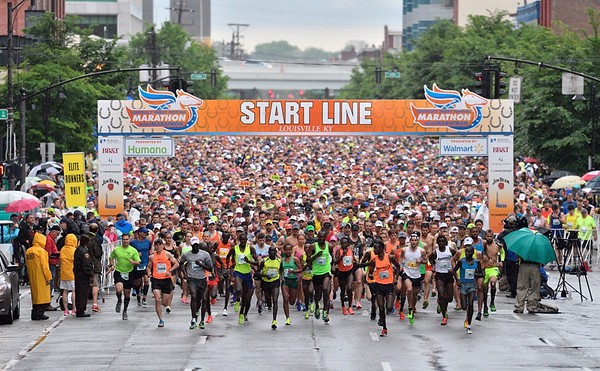BY MOLLY CUNNINGHAM
In the Arcadia Community Center in south Louisville’s Wilder Park neighborhood, a half-dozen Somali women sit on the couch in a brightly painted room chattering in Bantu. Each woman is wrapped from head to toe in cloths of varying colors and patterns, each carefully styled into a harmonized outfit. One woman hunches over a wide-ruled notebook on the coffee table, practicing her alphabet as she participates in the gossip.
The women escaped their war-torn home and immigrated to Louisville over the last few years, arriving here without the language skills or resources to begin again. But here in the community center, they are finding their bearings.
One Somali women has come forward to be the voice. Her name is Madina Sharif Hassan. She speaks English fluently and maintains a determination to turn her place of exile into a home.
With her help, the women gathered today are participating in the African Threads Project, in which a professional textile artist comes in to teach the women creative sewing skills meant to give them a platform to provide for their families while expressing themselves. The project is funded by the Kentucky Foundation for Women, which is celebrating its 20th year of supporting feminist art.
As KFW grantees, Madina and the other Somali women are now part of a larger community. They are Kentucky woman and unconventional feminists. They are expressing themselves while working to better their world, maintaining their traditions while trying to help other women. (Madina was originally set to be the interpreter for the program, but Isho Mohamed will now fill this role.)
Creating a tradition
Since its inception, the Kentucky Foundation for Women has provided financial support to women of different backgrounds and disciplines. The independent foundation was created in 1985 when former Courier-Journal heiress Sallie Bingham made a single donation of $10 million. It now grants $200,000 each year to promote social change through feminist art.
Despite this seeming specificity, the foundation sees terms such as “change,” “feminism” and even “expression” as fluid and better left to each artist to define for herself. That is borne out by the the work that’s been created by grantees; it covers a broad range across various disciplines, philosophies and mediums.
KFW evenly divides its spending into two grants. There’s the Art Meets Activism grant, which supported the African Threads project. It funds projects that are expressly meant to promote social change. The other grant is known as the Artist Enrichment grant; it provides funds for artists to hone their crafts.
Finally, another part of KFW’s budget — about $100,000, or 16 percent — maintains Hopscotch House, a Louisville retreat center that provides meeting space and “a room of one’s own” where artists can live temporarily.
KFW’s list of grantees over its first two decades reflects its diversity. Early grantees include Sena Jeter Naslund, Kentucky’s current poet laureate; Mama Yaa Asantewaa, a storyteller; Joyce Ogden, a sculptor who has organized public arts projects; and more recently, Anna Sapozhnikov, a modern dancer who has choreographed pieces on women’s issues, including a piece inspired by the stories of breast cancer survivors.
KFW Executive Director Judi Jennings says the foundation tries to challenge the status quo in the art world, which she sees systematically undermining female artists, and to encourage freethinking while supporting struggling women.
“We want artists and the public to think harder about what quality means,” she says. “In the United States, a particular ‘high art’ Western Europe definition of quality is dominant mostly because of museums and some galleries and collectors.”
Fiber artist Gwen Kelly, the consulting artist who helped organized the African Threads workshops, appreciates that nontraditional standard for art, particularly on this project, which features traditional stitching and quilting used to create original pieces of art. “African fabric has so many different layers to it,” Kelly says. “It has the meanings of the symbols, the colors and the process.”
To the Somali women, quality takes on a different meaning. Madina stresses how the project provides the women, who can find no other work because of language barriers, with greater opportunities for employment while also making them part of a larger community.
KFW’s philosophy is rooted in the conviction that positive social change occurs here, at the micro-community level among women and their families. Specifically, the foundation’s mission (at www.kfw.org) is “to promote positive social change through varied feminist expression in the arts.”
The foundation defines positive social change as action that eliminates societal barriers to women; neutralizes discrimination against women based on age, race, ethnicity, sexual orientation, physical ability, education, economic condition and geographic origin; and produces actions, conditions, policies, attitudes and behaviors that benefit women. It describes feminism as a “dynamic force for social change that varies across age, ethnicity, economic class, geography, sexuality, and other differences.” It leaves any strict definition of feminism up to the individual grantees.
While this lofty language calls for broad progress, the grants themselves answer artists’ immediate needs. But overall success is difficult to measure, as Bingham says. “Each individual artist would have to analyze what a grant has meant to her.”
Sapozhnikov, 29, said of one of her dance pieces: “I think it’s the effect of having the visual there in front of people. It’s not like I’m trying to make it easier for them. I’m just trying to show them a different way that they can get information.”
Sapozhnikov founded Moyamo Dance, a company featuring dancers and choreographers from the Midwest, and taught dance at the Youth Performing Arts High School. In 2003, she received a $4,000 Art Meets Activism grant for a dance piece on breast cancer, and in 2004 she received a $3,000 Artist Enrichment grant to produce “Fem,” a collection of works by women choreographers that focused on the depiction of women in media, relationships and history. “Fem” was staged this summer. Sapozhnikov is now a visiting assistant professor in dance at the University of Illinois at Urbana-Champaign.
Jennings echoes Sapozhnikov’s views, noting that art can portray new perspectives and get audience to see new ideas and issues and thereby create empathy.
Unconventional
It is not only the art of KFW that makes it unconventional. The foundation itself represents a collision of some of the most underrepresented areas of the foundation world, where about 15 percent of funding nationwide goes to the arts, 6-7 percent to women’s issues and less than 1 percent to social justice concerns, according to the Washington, D.C.-based National Committee for Responsible Philanthropy.
Jeff Krehely, deputy director of the organization, cites a reason for these low percentages and describes how that gives KFW a niche in the foundation world.
“People are turned off by more political things; having people rally around something that is artistic is a good way to facilitate some kind of larger participation,” he says.
Krehely also believes KFW’s regional focus helps it succeed. “Foundations and funders that are in the community and talking to people and are really part of the community will have a higher level of success in doing something that is really needed and really appreciated,” he says.
He contrasts community-based organizations with larger foundations, such as the Ford Foundation, that might support similar projects and drop in for a half-day visit, then try “to design a program for an area they spent four hours in.”
Expressing feminism through art
As feminism, art and the world have changed over the past 20 years, Jennings notes, so has KFW. Not, she says, by following trends but by accommodating new mediums and philosophies. She points out that feminists today have a greater consciousness of how women’s issues affect everyone. KFW has presented more than 1,100 grants in its 20-year history, totaling more than $6.5 million.
“Once we have better lives for women and girls, there will be better lives for all Kentuckians,” she says. “The change itself happens when those wonderful artists create new art in their studios and in their community. Their work is the change, the light showing the way to ways of thinking, doing, being.”
Madina’s eyes appear somber when she speaks in a steady voice of the horrors her family left behind in Somalia. “I tell my children, ‘You are here to learn and go forward. Let us think of our life.’” She says she has been working constantly for that life — not just for money, but for peace of mind. The African Threads project has been a part of that process. Asked about it, she smiles graciously and says, “It is a good way to make me forget about .”
In early October, the women received sewing machines, courtesy of KFW, which has also helped them gain independence and make their home in Kentucky. And while they may not be able to explain the connection between art and social change and feminism, they understand the concept.
“We can help them to help,” Madina said of the women and their families, nodding proudly.
Contact the writer at [email protected]





